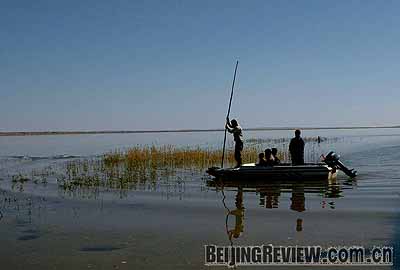|
Red grasslands started growing again in the Juyanhai Lake area of Inner Mongolia Autonomous Region last December after they had dried up many years ago. A water rights reform project in Zhangye of Gansu Province was responsible for their reappearance. As a major eco-environmental improvement, the red grasslands stretch for several miles alongside the lake, creating a great natural wonder for villagers who live in the area.
 |
|
BROUGHT BACK TO LIFE: Juyanhai, a giant lake on the lower reaches of the Heihe River in Inner Mongolia Autonomous Region, restored its river flow after more than 10 years of interruption. Juyanhai completely dried up in 1992 because of decreasing water flows | But it probably never occurred to the villagers that a small water rights certificate held by farmers in Zhangye 600 km away brought the red grass back to Juyanhai Lake. Nor did they know that a series of pilot projects on water rights trading, namely the transfer of rights to water from one legally approved water-using entity to another, would offer a new solution to the country's water shortages and a means of reviving its dry and degraded lakes and waterways.
By any fair measure, China is not a country with abundant water resources. Uneven distribution and low water productivity have made water scarcity even more severe. The country's scarce water resources pose major challenges for it to manage and sustain its economic growth in years ahead. It has been widely recognized that the allocation of water rights and the establishment of water markets could improve the efficiency of the country's water use and help resolve shortages.
Because there have been no other large developing countries for China to emulate in implementing tradable water rights, it has cut its own path since 2000. Since then, the country has made remarkable progress with some pilot projects in water rights trading, which serves as a promising approach for China to pursue in the years ahead.
Grim challenges
Last month, the World Bank published a report on the issue, entitled "Addressing China's Water Scarcity: Recommendations for Selected Water Resource Management Issues." It notes that the availability of China's per-capita renewable water resources was estimated at 2,156 cubic meters in 2007-an amount that was only one fourth of the world average of 8,549 cubic meters annually.
North China's per-capita water availability is only 757 cubic meters a year, less than one fourth that of south China, one eleventh of the world average, and less than the international "water scarcity" threshold of 1,000 cubic meters a year.
While China as a whole faces serious strains on water availability, its problems have been made more severe by low water productivity. According to the World Bank report, China's water productivity cost of $3.6 per cubic meter is low compared with an average of $4.8 per cubic meter in middle-income countries and $35.8 per cubic meter in high-income nations.
The report also pointed out that a major contributor to China's low water productivity is its very inefficient water allocation system. A recent study of the Haihe River Basin in north China, one of the country's seven major river basins which is located in an extremely water-deprived region, found that the cost of water productivity, as reflected by the economic value of water for different uses, ranged from 1 yuan ($0.15) per cubic meter for paddy irrigation, 12.3 yuan ($1.81) per cubic meter for vegetable production, 21.3 yuan ($3.13) per cubic meter for manufacturing, and 33.7 yuan ($4.96) per cubic meter for the services sector. The magnitude of the cost differences indicated a serious lack of market consciousness in the water allocation process, the report said.
The very first attempt
Water has long been considered a generous and free gift from heaven, and people have taken for granted that its supply is limitless. Given the strains on water supplies, it is common for disputes about who owns water and who has the right to use it to arise from time to time. In north China, before the first water law was issued in 1988, squabbles over water occurred frequently, which destroyed social stability, said Ke Lidan, the former director of department of policy, law and regulation at Ministry of Water Resources of China, in an article on Outlook Weekly.
In China, the state is the legal owner of water rights. But in the past it did not clearly define the rights to water usage and whether they could be transferred among different water use entities. This created problems in some cases, causing inefficient water allocation and a huge waste of limited water resources. The Water Law of 2002 sought to correct this by introducing a water right that laid the foundation for the compensated use of water resources.
|
